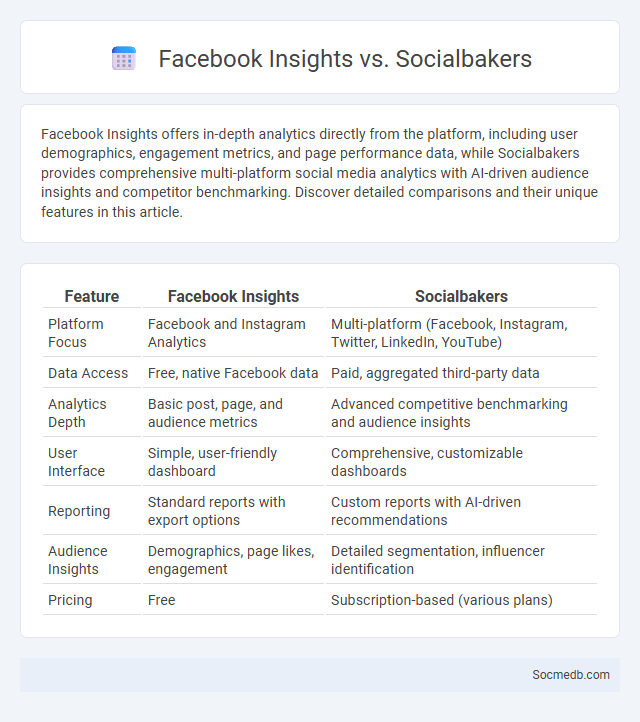
Photo illustration: Facebook Insights vs Socialbakers
Facebook Insights offers in-depth analytics directly from the platform, including user demographics, engagement metrics, and page performance data, while Socialbakers provides comprehensive multi-platform social media analytics with AI-driven audience insights and competitor benchmarking. Discover detailed comparisons and their unique features in this article.
Table of Comparison
| Feature | Facebook Insights | Socialbakers |
|---|---|---|
| Platform Focus | Facebook and Instagram Analytics | Multi-platform (Facebook, Instagram, Twitter, LinkedIn, YouTube) |
| Data Access | Free, native Facebook data | Paid, aggregated third-party data |
| Analytics Depth | Basic post, page, and audience metrics | Advanced competitive benchmarking and audience insights |
| User Interface | Simple, user-friendly dashboard | Comprehensive, customizable dashboards |
| Reporting | Standard reports with export options | Custom reports with AI-driven recommendations |
| Audience Insights | Demographics, page likes, engagement | Detailed segmentation, influencer identification |
| Pricing | Free | Subscription-based (various plans) |
Overview of Facebook Insights, Socialbakers, and Insights
Facebook Insights provides comprehensive analytics on your page's performance, including user engagement, reach, and demographics. Socialbakers offers competitive social media intelligence, tracking audience growth, content performance, and industry benchmarks across multiple platforms. Leveraging these tools enables you to optimize your social media strategy through data-driven insights and targeted content adjustments.
Key Features Comparison
Social media platforms vary widely in key features such as content sharing formats, audience reach, and user engagement tools. Facebook excels in community building with groups and events, Instagram prioritizes visual content through photos and reels, while Twitter focuses on real-time updates and microblogging. TikTok's algorithm-driven short videos foster viral trends, and LinkedIn offers professional networking with job postings and industry news.
User Interface and Experience
A well-designed social media user interface (UI) enhances user engagement by providing intuitive navigation, visually appealing layouts, and seamless interaction elements tailored to diverse user preferences. Optimized user experience (UX) ensures fast load times, personalized content delivery, and accessibility features, which collectively increase session duration and reduce bounce rates. Continuous usability testing and data-driven UI upgrades are critical to adapting social media platforms to evolving user behaviors and technological advancements.
Data Accuracy and Reliability
Ensuring data accuracy and reliability on social media platforms is crucial for making informed decisions and maintaining trust. Your analytics depend on clean, verified data to track engagement metrics like click-through rates, impressions, and follower growth accurately. Regular audits and advanced algorithms help eliminate fake accounts, bots, and misleading interactions, enhancing your data's credibility.
Audience Analytics Capabilities
Audience analytics capabilities in social media enable precise understanding of your followers' demographics, behaviors, and preferences through data segmentation and engagement tracking. Advanced tools utilize machine learning algorithms to analyze patterns, predict trends, and optimize content strategies for maximum impact. Leveraging these insights empowers you to tailor messaging effectively and enhance ROI across various social platforms.
Reporting and Customization Options
Social media platforms offer comprehensive reporting tools that provide detailed insights into audience engagement, content performance, and demographic trends. Customization options allow you to tailor reports with specific metrics, timeframes, and visual formats to align with your marketing objectives. Leveraging these features ensures your social media strategy is data-driven and optimized for maximum impact.
Integration with Other Platforms
Social media platforms increasingly prioritize seamless integration with other digital tools such as e-commerce, customer relationship management (CRM), and content management systems (CMS) to enhance user experience and streamline workflows. Features like single sign-on (SSO), API connectivity, and cross-platform sharing capabilities enable marketers and users to synchronize data and maintain consistent branding across multiple channels. This interconnected ecosystem improves campaign performance, facilitates real-time analytics, and drives higher engagement rates by creating a unified online presence.
Pricing and Subscription Models
Social media platforms offer diverse pricing and subscription models, ranging from free access supported by ads to premium tiers with advanced features such as ad-free browsing, enhanced analytics, and exclusive content. Subscription models like monthly or annual payments provide users with customized experiences tailored to their engagement levels and business needs. Understanding these options helps you select the best social media service to fit your budget and maximize your online presence.
Pros and Cons of Each Tool
Social media platforms like Facebook, Instagram, Twitter, LinkedIn, and TikTok offer unique benefits and drawbacks that influence your digital presence. Facebook excels in community building but can suffer from algorithm-driven content limitations, while Instagram emphasizes visual storytelling but may promote unrealistic lifestyle standards. Twitter allows real-time updates and direct engagement, though it often struggles with misinformation, LinkedIn provides professional networking opportunities but can feel overly formal, and TikTok drives viral content with creative expression yet raises concerns about data privacy and screen time.
Which Analytics Tool Is Best for Your Business?
Choosing the best social media analytics tool depends on your business goals, platform usage, and budget. Tools like Hootsuite Analytics excel in comprehensive multi-platform tracking, while Sprout Social offers detailed audience insights and post-performance metrics ideal for customer engagement strategies. For businesses prioritizing influencer marketing and hashtag analysis, Brandwatch provides advanced social listening capabilities to optimize campaign impact effectively.
 socmedb.com
socmedb.com